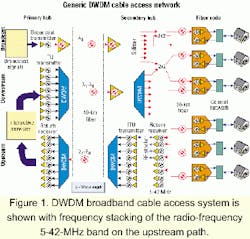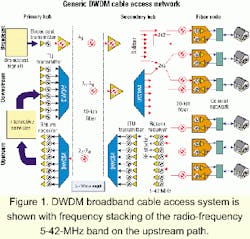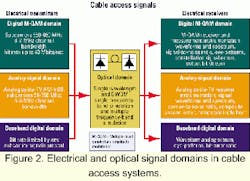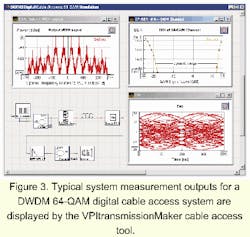Network architectures combine broadband, data, voice services
New simulation and design techniques for hybrid fiber/coaxial-cable access systems.
ARTHUR LOWERY and DON HEWITT,
Virtual Photonics Inc.
The rapid deployment of fiber-optic technology into traditional hybrid fiber/coaxial (HFC) cable-TV systems is transforming cable multiple-service operators (MSOs) into full telecommunications service providers. In addition to providing analog and digital broadcast-television services, MSOs now provide high-speed Internet access, Internet Protocol (IP) telephony, and other advanced interactive digital services over two-way broadband networks.
Cable access networks use DWDM technology and novel return-path architectures to meet the increasing demands for more interactive bandwidth in the customer access network. Fiber is being deployed closer to the customer with the intention of making the final coaxial network completely passive for improved reliability.
An example of a current optical broadband cable access system is shown in Figure 1. The design uses one optical wavelength to transmit downstream analog and digital broadcast video signals from the primary hub to all fiber nodes. The use of erbium-doped fiber amplifiers in the 1,550-nm optical window is the enabling technology making this possible. Additional DWDM optical channels that can be directed to one or more fiber nodes provide segmentation of downstream interactive services.In the upstream direction, DWDM technology is also used to provide more return channels on the one fiber from the secondary to the primary hub. Radio frequency (RF) return channels (5 to 42 MHz) in the coaxial network connected to customers are time-division multiplexed before driving the laser in each fiber node. Each return channel is also frequency upconverted at the secondary hub with frequency stacking of four return channels taking place before modulation of a DWDM return laser.
Emerging cable access architectures utilize extra active or passive local hubs to increase upstream bandwidth per home passed and eliminate RF amplifiers in the coaxial-cable network. Analog return channels are being converted to digital channels using high-speed analog-to-digital (A/D) converters. Optical component counts in evolving cable access systems are high. The performance of lasers, optical amplifiers, nonlinear fiber, multiplexers and demultiplexers, and other optical components is critical to the overall design. System providers are demanding sophisticated simulation tools to aid the design process and optimize system performance.
HFC cable access networks are rapidly expanding their range of telecommunications applications using interactive digital services. The new cable access services directly compete with incumbent local-exchange carriers (ILECs) and competitive local-exchange carriers (CLECs) with the rollout of DSL for the provision of broadband services. Flexible fiber-intensive cable access architectures must continue to evolve to meet the increasing challenge of low-cost, high-capacity, broadband interactive systems.
Cable access systems (see Figure 1) use RF subcarriers ranging from 5 MHz to 1 GHz to carry analog and digital-TV signals, digital data, and telephony signals. Digital data is carried on multiple-level quadrature amplitude modulation (M-QAM) carriers, and signal-to-noise ratios (SNRs) should be much higher than conventional baseband digital optical systems. Nonlinear distortion in both electrical and optical signal domains must be tightly controlled for optimum network performance.
Optical cable access system designers should consider the following:
- Impairments of the transmitter, including modulation response of the laser, clipping and transient recovery of the laser and modulator, nonlinearity of electro-absorption and Mach-Zehnder modulators, relative-intensity noise in the laser, and nonlinearity of directly modulated lasers.
- Fiber distribution network impairments, including fiber dispersion on frequency response and distortion; phase distortion of optical filters; fiber nonlinearity-cross-phase modulation, four-wave mixing (FWM), stimulated Raman scattering causing optical cross-coupling and baseband nonlinearities; stimulated Brillouin scattering; optical amplifier gain tilt and noise; multi-optical-path interference; and performance of optical multiplexers and demultiplexers.
- Performance of receivers, including optical receiver noise and amplified spontaneous emission (ASE)-signal beat noise, decoding of digital M-QAM signals, correct synchronization of in-phase and quadrature-phase QAM demodulation.
Cable access networks must handle a diverse range of electrical signal formats such as analog cable TV, digital binary baseband, and digital M-QAM subcarriers (see Figure 2). An advantage of cable access system architectures using channel information on separate subcarriers is that data formats and transmission protocols may be different on each subcarrier channel. The bandwidth for each signal domain will depend on information content and require a different sampling rate for optimum simulation time and memory requirements. The bandwidth requirement of the optical domain will always be larger than that of the electrical domains due to the linewidth of optical sources, optical signal processing, and WDM options. Up and down sampling rates for each domain must be optimized for efficient simulation.
To maintain traditional services, broadcast analog cable-TV signals need to be carried on cable access systems along with digital-TV broadcast and narrowcast signals. Analog cable-TV test signals require multiple carrier generators with random or fixed phase excitation set to National Television Standards Committee (NTSC) or Phase Alternate Line (PAL) frequency plans. Nonlinearities and noise arising from electrical, optoelectronic devices and fiber nonlinearities are measured in analog cable access systems by standard cable-TV measurement procedures-carrier-to-noise ratio (CNR), composite second order, and composite triple beat intermodulation distortion.
Simulation of analog optical-fiber access systems allows intermodulation distortion of all channels to be predicted at one time, and poor channels may be readily identified. CNR measurement procedures may include all nonlinear distortion and noise terms in an NTSC 6-MHz-wide channel, and the use of multidimensional sweeps can optimize system performance and design tolerances. Setting drive levels for an acceptable amount of dynamic laser clipping is one simulation example where maximum optical-fiber distribution capacity may be balanced against an intermodulation distortion specification.
Digital video broadcast systems take input from the MPEG-2 (Motion Picture Experts Group) transport layer, adding MPEG framing information and forward error correction, before encoding the bit sequence as a multilevel M-QAM RF carrier. The electrical RF QAM signal modulates the optical carrier at the primary hub, and transmission takes place along the fiber through a secondary hub to an optical receiver at the fiber node. High-speed data-over-cable modems allow transparent bidirectional transfer of IP traffic between the cable access headend (or primary hub) and customer locations. M-QAM carriers may carry IP data traffic via the cable modem terminating system or broadcast digital video originating from the primary hub.
A simulation tool for digital cable access systems must provide multilevel eye-pattern visualizers, SNR measurement capability, and QAM signal constellation error instrumentation. Electrical M-QAM transmitter and receiver models are required for conversion of pseudo-random bit streams at downstream and upstream transmitters for optical-fiber transmission of M-QAM carrier data and conversion back to binary data streams at the receiver.
Current simulation tools can accurately predict M-QAM eye-patterns, SNR, and constellation signal errors. Practical simulation times are far too short to directly simulate bit-error ratio (BER) to the low values required in typical system specifications. Simulation is, however, an excellent tool for identifying the source of SNR ceilings, which give rise to BER floors. Electrical and optical nonlinearities, optical cross-coupling effects, and the many optical and electrical noise contributions may be readily identified and studied with simulation tools. BER is useful for end-to-end system measurements. SNRs are more useful for investigating parts of complex systems and may be carefully cascaded in the design processes.Cable access systems may be studied with simulation techniques to check if Added White Gaussian Noise (AWGN) assumption is valid. Analytical AWGN expressions relating SNR to expected BER may be applied (see Figure 3) to predict the dynamic range of a 64-QAM cable access channel.
An M-QAM signal constellation visualizer is a standard cable industry measurement tool. QAM constellation visualizers are often able to identify the source of system degradation. For example, an interfering ingress carrier in the channel band will appear as a circle around each symbol position. The corresponding eye-diagram would show a partially closed eye, but the source of the eye-closure cannot be easily inferred.
Simulation is often a very useful tool for demonstrating the effects of complex nonlinear phenomena on system performance. FWM in nonlinear optical fibers is well known in digital systems, though not as strong in standard singlemode fibers (SSMF) at 1,550 nm due to high dispersion. The high dispersion causes revolving phase mismatch between the propagating FWM tone and the local contribution to it, as the signal propagates along the fiber. That is often cited as one reason FWM is not important in cable access systems.
Simulation tools, however, predict FWM as a potential serious problem if the optical carriers are not exactly on a regular frequency grid, due to wavelength drift of the sources, for example. The reason is that optical carriers themselves will produce strong optical FWM tones that may fall on the modulation sidebands of adjacent channels. Upon photodetection, the optical FWM products convert to RF tones that are strong relative to the signals, causing degradation of both analog and digital cable access signals.
Figure 3 shows the received optical spectrum of four DWDM channels, spaced nominally at 50 GHz, with the second-highest frequency carrier displaced upwards in optical frequency by 627 MHz from the regular frequency grid. In this case, the lasers were operated at 5 mW with 10-MHz line widths. The second optical carrier is modulated with 30 subcarriers, each bearing a 30-Mbit/sec 64-QAM signal. The optical carriers are multiplexed, sent through a 40-km SSMF fiber, then demultiplexed. Also shown are the FWM mixing products that fall outside the original channel. FWM products also fall close to the original channels but are obscured by the channel sidebands.
Receivers are used to observe the RF spectra, and a full QAM decoder for one subcarrier will display an eye-pattern. Analysis of the possible FWM products also shows that a tone at 627 MHz will be present, interfering with a 64-QAM signal. This interference tone can cause complete eye-closure of the 64-QAM signal transmitting in this channel.
Return channels for HFC networks in the coaxial system are limited to the frequency band of 5-42 MHz. An important technical challenge is how to meet the ever-increasing speed and channel requirements for interactive data transmission. One solution is to use frequency stacking of different return channels on DWDM return optical channels (see Figure 1). Another option uses high-speed A/D conversion of each analog return channel and utilizes standard baseband digital optical systems with DWDM return optical channels back to the headend. The entire analog return RF spectrum is carried back from the fiber node by a low-cost baseband digital system as a continuous stream of ones and zeros. Simulation of such systems allows effects of quantization noise and over-ranging to be investigated, an effect similar to laser clipping in analog upstream channels.
Cable access operators are embarking on extensive network upgrades with a high utilization of emerging lightwave technology. Fiber is being driven deeper into the cable access network to reduce costs, increase capacity, improve reliability, and extend reach. HFC networks must provide an expanding range of telecommunications services from video, voice, and data to meet the competitive broadband technologies of asymmetric and very-high-speed DSL, currently being rolled out by ILECs and CLECs.
Recently developed cable access simulation software is capable of investigating the complex nonlinear impairments of emerging HFC cable access system architectures. Designers now have an additional tool-quicker and more cost-effective-to optimize network performance and investigate new architectures. Simulation tools are being used by MSOs to broaden the basic detailed understanding of their evolving HFC networks across all sections of the workforce. The ability to quickly change or study particular aspects of networks without the need to involve costly system hardware is a great advantage and provides flexibility.
The use of cable access simulation software is also being extended to staff training operations as well as assist technical sales. In essence, it has evolved into a unifying company tool enabling the demonstration of new access systems on a simple laptop. In the competitive cable access marketplace, design and simulation software is providing advanced network capabilities, but fiber-intensive cable access architectures will have to continue to evolve to meet the increasing demand for low-cost, high-capacity, broadband interactive systems.
Arthur Lowery is the group technology officer and Don Hewitt is the group's senior software engineer in Virtual Photonics Inc.'s (Holmdel, NJ) optical systems group.



